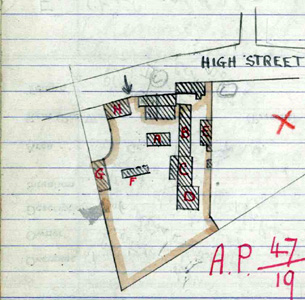Harrold Leather Manufacturing Company Limited

Site of the former leather works, June 2008
Harrold has long been associated with the leather working industry. The earliest mention in any record held by Bedfordshire Archives is in a will of 1782 [ref: ABP/W1786/40] in which Stephen Morris of Harrold, fellmonger, devised his house to his wife Mary. She died without proving her husband's will which was proved by her executrix, Elizabeth Crawley, in 1786 - Stephen Morris' estate was valued below £20. In 1795 a cottage and fellmonger's shop, yard and gardens in Harrold in occupation of Samuel Parsons at a rent of £4/15/- formed part of the estate of James Milward [ref: GA992-3].
Bedfordshire Archives holds a number of 19th and early 20th century directories and these include the following references to leather working:
- 1839-1850: Samuel Parsons, fellmonger, perhaps the same man as mentioned in 1895, or a relative;
- 1847-1870: Thomas Parsons, described as a fellmonger, also, in 1853, a carrier;
- 1853-1870: Edward Rate, described as a fellmonger, in 1854 also a shopkeeper;
- 1877-1894: Charles Pettit, leather-dresser, in 1894 he was living in Harrold House, he later became a JP;
- 1910-1920: Pettit & Company;
- 1924: Harrold Leather Company Limited, run by John Charles Tusting;
- 1928: Harrold Leather Manufacturing Company.
John Charles Tusting married Charles James Pettit's daughter and so succeeded to his business. A snippet from the Bedfordshire Mercury of 15th September 1888 shows how reliant on the owner the business, and its workers, was: "Mr.C.Pettit, who was thrown from his trap a short time since, has been obliged to close his leather yard and go away for change, thus throwing many out of work".

Leather Factory layout in valuer's notebook [ref: DV1/C71]
The biggest leather works lay, in the early 20th century, behind the southern part of the High Street. In 1927 property in Harrold was valued under the Rating and Valuation Act of 1925; every piece of land and building in the country had to be valued to determine the rates to be paid upon it. The valuer visiting Harrold Leather Manufacturing Company's premises [ref: DV1/C/71/141-144] noted that the site extended to 1.530 acres and he noted the following groups of buildings - all shown on the plan below:
- A: brick and tile and brick and slate offices and warehouse, wooden floor, 9 inch walls, one storey (56 feet by 22 feet by 13½ feet)
- B: brick, stone and tile two storeys, 15 inch walls, part first floor with wooden shutters; finishing room and dye store (64½ feet by 15½ feet); heated drying room (67 feet by 18 feet by 22½ feet)
- C: brick, stone and tile two storeys, 18 inch walls, heavy machines, "good" machine room (51 feet by 19 feet), heated drying room (51 feet by 19 feet), brick annexe (36 feet by 16½ feet by 11½ feet)
- D: new addition ("very good") brick and asbestos tile, two storeys, 14 inch walls, concrete floor; "good" machine room 38 feet by 38½ feet; drying room (38 feet by 38½ feet); chimney shaft, square, 44 feet high
- E: new warehouse, brick and slate, one storey, 9 inch walls, concrete floor; "good", 50 feet by 23½ feet; wood and corrugated iron store;
- F: stone and slate old two bay open shed and two stores;
- G: stone and tile barn used as garage and warehouse, concrete floor 24 feet by 60 feet outside
- H: brick and slate old stable with loft over used as store
The valuer noted that the machinery consisted of a 24hp steam engine with a 13 feet by 2 inch main shaft. He also remarked: "Own electric light"; "Building now renovated - very substantial. Plenty of room. At full work Aug 1927 looks a good factory" and "Shortness of water a disadvantage. No proper drainage. Lorry to Northampton Station".